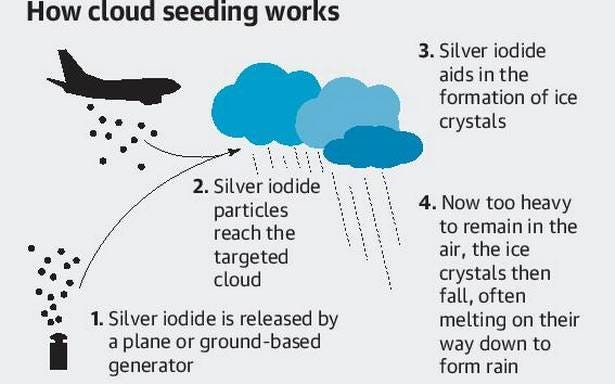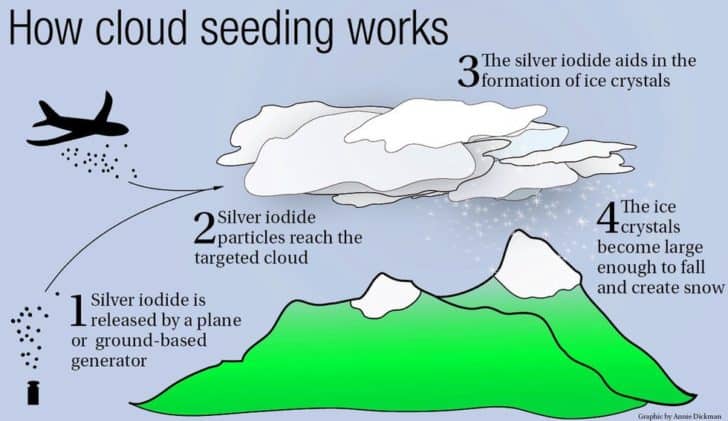CLOUD SEEDING: DEFINITION, HOW IT WORKS AND IMPACT
Cloud seeding is a way to artificially tweak rain. It is also known by other terms such as man-made precipitation enhancement, artificial weather modification, rainmaking and so on.Vincent J.Schaefer invented cloud seeding.Cloud seeding was used in the Vietnam War.
Cloud seeding is an artificial way of inducing moisture in the clouds to cause rainfall. It is a form of weather modification. Just like a farmer sowing seeds in the field, which later grow to crops, in cloud seeding the clouds are filled with ‘seeds’ to later fall as rain. The seeds in this case are nothing but the silver iodide, potassium iodide and dry ice.
Condition Required For Cloud Seeding
Right atmospheric conditions with plenty of clouds that are capable of rain is required for cloud seeding. We cannot go and seed the clear skies. Clouds form from the condensation of invisible water vapor on nuclei from dust, pollen and salt from ocean spray. Cloud seeding increases the number of these available nuclei. Raindrops or ice crystals might not form without these added nuclei.
Advantages of Cloud Seeding
Creates rain
It does not just make rain, it also regulates water vapor that in turn prevent damages bought by destructive hails and storms
It saves dry place from drought
Disadvantages of Cloud Seeding
It uses chemicals which can harm the environment especially plants and animals. Though silver iodine is not currently known to be harmful to our health today, but it might change in the future as more research is done on that.
The technique is mostly used on clouds that already show early signs of rainfall, so it is not known if it actually causes rain.
Since it modifies the weather it might change climatic pattern.
It is very expensive.
TYPE OF CLOUD SEEDING
Static Cloud seeding: This first of three methods work when a chemical compound is spread onto the clouds. It is the most commonly used method and involves the spraying of particles of salt, like silver iodide and chloride onto clouds.
Silver iodide (AgI) exists in the environment naturally and is not harmful to humans or wildlife. To do so, a special aircraft, rocket, or other dispersion device is used.
The salt particles act as a condensation nucleus, drawing water vapor within the cloud towards them.
Moisture will then latch onto them, condensing into water droplets. Subsequently, raindrops form, leading to rainfall.
Dynamic Cloud Seeding: This second type of seeding works by boosting the vertical air currents, encouraging more water to pass through the clouds. It, therefore, translates to more rain.
For it to work, about 100 times more ice crystals are required as compared to the static cloud seeding method. It is a more complex method as it relies on a sequence of events working properly.
Scientists within the atmospheric science departments as well as other researchers have broken the dynamic cloud seeding method into eleven separate stages. If one of the stages fails or its outcome is unexpected, the entire process is ruined. It also makes the technique less dependent as compared to the static cloud seeding method.
Hygroscopic Cloud Seeding: This last type utilizes the dispersal of salts through flares or explosives onto the lower parts of a cloud. The salt will become bigger and water will join it. It is a relatively new method that has been described as ‘promising.’ It, however, requires more research.
The goal of cloud seeding is to alter the natural development of the cloud to enhance precipitation, suppress hail, dissipate fog, or reduce lightning. Various cloud seeding techniques are employed, as particles are released from rockets, aircraft, or ground. The seeding of ice-phase clouds can induce the phase transition from a supercooled water cloud to one composed of ice. In the case of dynamic cloud seeding, the purpose is to stimulate vertical air motions through increased buoyancy caused by the release of latent heat of freezing.
What is the impact of cloud seeding?
Despite increasing popularity, there are a lot of unknowns with cloud seeding. The success of the technology and its long term impacts are still debated by scientists.
In 2003, the United States’ National Research Council (NRC) report on Critical Issues in Weather Modification Research highlighted the need to address key uncertainties in our understanding of cloud seeding. Studies have called for investigations into the efficacy of cloud seeding and to quantify cloud seeding impact.
For instance, a recent attempt to induce rain amid a prolonged drought in Sri Lanka has fallen short, drawing criticism, with experts calling for scientific assessments before expensive long-term programs are envisaged. But that hasn’t stopped the government from embracing the project.









0 Comments